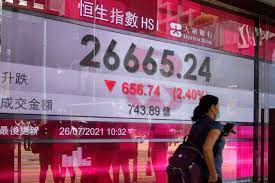Bangkok, July 26:Asian shares were mixed on Monday after stocks rallied to records on Wall Street, with the Dow Jones Industrial Average closing above the 35,000 level for the first time.
Tokyo advanced after a 4-day weekend as the Olympic Games began, a year late. Benchmarks fell in Hong Kong and Shanghai but rose in Sydney.
Preliminary factory and service activity surveys in Japan showed a slowdown linked to recent tightening of pandemic precautions due to surging coronavirus cases.
The flash purchasing managers index for the services sector fell to 46.5 in July from 48 in June, on a scale of 1-100 where 50 marks the break between expansion and contraction.
Manufacturing remained in expansion, but fell to 50.5 from 50.7 in June, said the au Jibun Bank survey. It said new export orders declined, possibly reflecting supply bottlenecks. Output fell at the fastest pace in six months.
“Short-term disruption to activity is likely to continue until the latest wave of COVID-19 infections passes and restrictions enacted under the state of emergency laws are lifted,” Usamah Bhatti, economist at IHS Markit, said in a report.
Nonetheless, Tokyo’s Nikkei 225, tracking Wall Street’s strong finish on Friday, gained 1.2% to 27,864.79. In Australia, the S&P/ASX 200 edged less than 0.1% higher, to 7,397.60, while the Kospi in Seoul declined 0.4% to 3,240.46.
Hong Kong’s Hang Seng sank 2.9% to 26,527.06 after Chinese regulators said they were further tightening restrictions on tech companies. The Shanghai Composite index dropped 2.2% to 3,473.13.
On Friday, the Dow, S&P 500 and Nasdaq all finished with gains of better than 1% for the week.
They each returned to records after brushing aside the sharp downturn that trimmed 1.6% off the S&P 500 on July 19. But the market rebounded as big companies reported better profits than expected and as investors once again saw any dip in stocks as merely a chance to buy low.
The S&P 500 index climbed 1% to 4,411.79. The Dow rose 0.7% to 35,061.55 and the Nasdaq composite gained 1% to 14,836.99.
Despite a rebound in new coronavirus cases, the U.S. Economy continues to recover at a torrid pace, with the question being how much growth will slow in upcoming months and years.
A preliminary report from IHS Markit on Friday indicated U.S. Manufacturing growth may have unexpectedly accelerated this month, though growth in services industries looks to be slowing more than economists expected.
The yield on the 10-year Treasury was steady at 1.26% on Monday. It has dropped from a perch of roughly 1.75% in late March, reflecting alarm over rising inflation.
With roughly a quarter of all the profit reports in from S&P 500 companies, nearly 90% have topped Wall Street’s already high expectations for the spring.
Companies in the index are on pace to report roughly 74% growth for earnings in the second quarter from a year earlier, according to FactSet. That would be the strongest growth since the economy was exploding out of the Great Recession at the end of 2009.
S&P 500 businesses appear on track to say they made $124 in profit for every $1,000 in sales, according to FactSet. That would be a slight dip from $128 during the first three months of the year, but it would remain comfortably above the average of $108 over the last five years.
In other trading, U.S. Benchmark crude oil lost 47 cents to $71`.60 per barrel in electronic trading on the New York Mercantile Exchange. It picked up 16 cents to $72.07 on Friday.
Brent crude, the international pricing benchmark, declined 38 cents to $73.72 per barrel.
The U.S. Dollar fell to 110.35 Japanese yen from 110.51 yen. The euro rose to $1.1780 from $1.1776. (Agencies)
Trending Now
E-Paper


